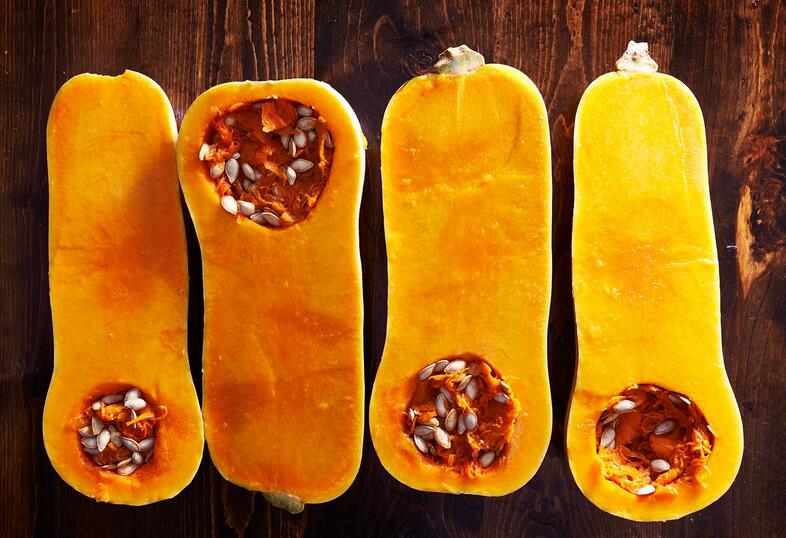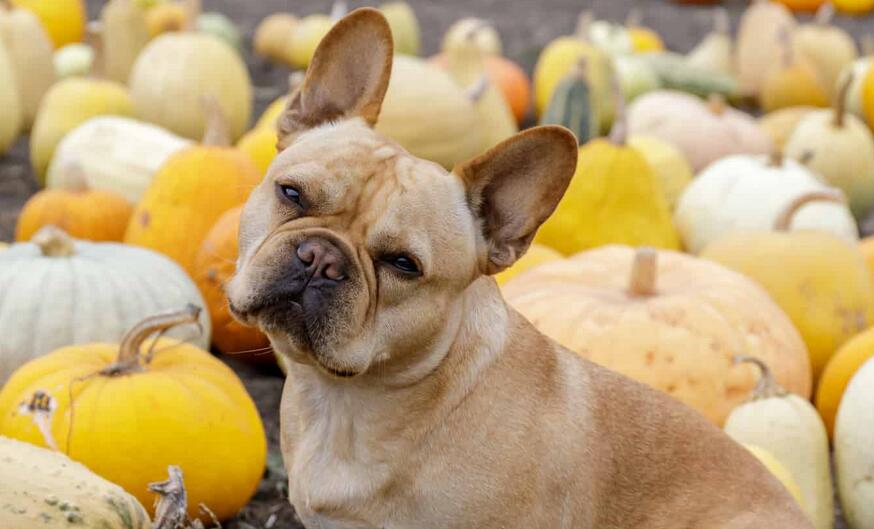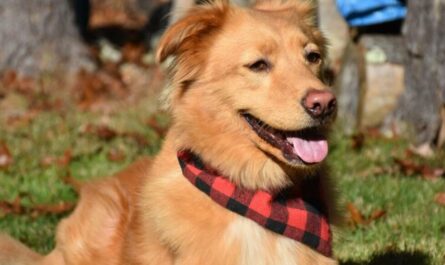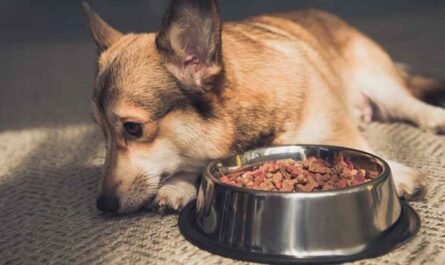As pet owners, we always want to ensure that our furry friends get the best nutrition possible. That’s why we carefully choose the food we give them. However, sometimes we’re unsure if certain human foods are safe for our dogs. One of these foods is butternut squash.
Table of Contents
ToggleButternut squash is a popular vegetable that many humans enjoy thanks to its sweet and nutty flavor. But can dogs eat butternut squash too? In this article, we’ll take a closer look at this question and provide you with everything you need to know about feeding your dog butternut squash.
What is Butternut Squash?
Butternut squash is a type of winter squash belonging to the Cucurbitaceae family along with pumpkins, zucchini and cucumbers. The squash has tan, butter-colored skin and sweet, bright orange flesh when cut open. Butternut squash grows on vines and ripens in late fall and early winter. The edible seeds inside are also highly nutritious.
Butternut squash is an excellent source of essential vitamins and minerals. It’s high in vitamin A, which supports healthy vision, soft skin and coat. It also contains vitamin C for immune health, B vitamins for energy, potassium for muscle function and magnesium for bone development. Butternut squash provides a good amount of fiber when cooked as well.
Potential Health Benefits for Dogs
With its stellar nutritional profile, incorporating some butternut squash into a dog’s diet can provide the following benefits:
- Strengthens vision – Butternut squash is rich in carotenoids like beta-carotene which convert to vitamin A to support eye health.
- Boosts immunity – The vitamin C content in butternut squash acts as an antioxidant and helps stimulate the immune system.
- Improves digestion – The natural fiber in squash adds bulk to stool and promotes regular bowel movements.
- Supports bone strength – Magnesium and vitamins A, C and K in squash help build and maintain strong bones.
- Nourishes skin and coat – Vitamin A and healthy fats in butternut squash nourish skin and give fur a glossy shine.
- Provides energy – Squash contains B vitamins that help convert food into energy and boost metabolism.
- Maintains muscle function – The potassium in squash ensures proper nerve signaling and muscle contraction.
When incorporated into a balanced diet and fed properly, butternut squash can provide valuable nutritional support for a dog’s overall health and wellness.
Safety Concerns of Feeding Butternut Squash to Dogs
While butternut squash has many benefits, there are some important safety considerations to keep in mind when feeding it to dogs, including:
- Choking hazards – The tough, stringy texture of raw squash or skin may present choking risks. Dogs should only be fed cooked squash puréed or mashed.
- Gastrointestinal issues – Too much fiber can cause loose stool or diarrhea in dogs if not acclimated. Introduce slowly and monitor bowel movements.
- Allergies – Dogs may have sensitivities or allergies to squash. Look for signs like itching, swelling, vomiting or diarrhea.
- Natural toxins – Raw squash may contain traces of toxins like cucurbitacins that could cause illness in dogs. Always cook thoroughly.
- Weight gain – Butternut squash is high in natural sugars and calories that can quickly lead to obesity if overfed. Stick to portion guidelines based on your dog’s weight and activity level.
- Nutritional imbalance – Too much squash can crowd out other important proteins, vitamins and minerals in your dog’s diet. Feed as a treat, not a dietary staple.
While butternut squash can provide valuable nutrition for dogs, it should always be fed properly and in moderation. Consult your vet before introducing any new foods.

Are Dogs Allowed to Eat Butternut Squash Skin?
It is not recommended to feed dogs the tough outer skin of butternut squash. The skin is very thick and fibrous which can present a choking hazard for dogs. Swallowing large pieces of squash skin may cause an intestinal or esophageal obstruction.
The skin is also difficult for dogs to digest properly. Eating large quantities of squash skin could potentially lead to gastrointestinal issues like vomiting, diarrhea or constipation. To be safe, the skin should always be removed before cooking and serving butternut squash to dogs.
If a small amount of skin is accidentally ingested, it likely won’t cause major issues. But the skin provides no real nutritional value, so it’s best to peel it off to avoid any digestive discomfort or choking risks. Mashed or puréed squash flesh is much safer and easier for dogs to consume and digest.
Can Dogs Have Raw Butternut Squash?
It is not recommended to give dogs raw butternut squash. The dense, tough flesh of raw squash is difficult for dogs to adequately chew and digest. Feeding a dog raw butternut squash may put extra strain on the digestive tract and potentially cause stomach upset, gas, vomiting or diarrhea.
Raw squash also contains insoluble fiber such as cellulose that doesn’t break down during digestion. Too much insoluble fiber can cause excess loose stool. Cooking the squash softens the flesh and makes the nutrients more bioavailable and easier on your dog’s stomach.
There are also traces of toxic compounds called cucurbitacins present in raw winter squash that could cause adverse reactions if a large amount is consumed. Always cook butternut squash thoroughly before serving to ensure all toxins are eliminated.
For safety and digestibility, butternut squash should be peeled, seeded, cooked until very tender, then mashed or puréed before feeding to dogs.
Are Butternut Squash Seeds Harmful for Dogs?
Butternut squash seeds are not inherently toxic to dogs. However, they should be fed in strict moderation. The hard outer shells of squash seeds can potentially cause intestinal blockages or irritation in a dog’s throat and stomach if large quantities are consumed.
It is recommended to remove all the seeds from butternut squash before cooking and serving it to dogs. The flesh provides the most nutritional value, not the seeds. However, small amounts of seeds blended into a dog recipe or food processor are generally fine.
If your dog happens to ingest a few seeds, they will likely pass through the digestive tract without issue. Just don’t intentionally feed dogs bowls full of raw squash seeds, as overconsumption could pose a risk of gastrointestinal obstruction or discomfort.
Can Dogs Eat Butternut Squash?Why Portion Control Matters
It’s imperative to practice portion control when introducing butternut squash or any new human foods into your dog’s diet. Dog stomachs are much smaller than human’s, so they need significantly less volume of food. Overfeeding butternut squash can lead to diarrhea, vomiting and weight gain in dogs.
Butternut squash is higher in natural sugar and carbohydrates than some other veggies. The calorie count can quickly add up if dogs are fed too much. Obesity is extremely common in dogs and can cause numerous health complications. Stick within recommended serving sizes based on your dog’s weight, breed and activity level.
Variety and balance are also crucial for your dog’s nutritional needs. Butternut squash should not make up more than 10% of their total daily food intake. Focus on quality protein sources like meat and fish with veggies mixed in.
What is a Safe Butternut Squash Serving Size for Dogs?
When introducing butternut squash to your dog’s diet, always start with small servings and adjust amounts based on their individual tolerance. The exact serving size can vary based on your dog’s weight, breed, age and activity level.
As a general guideline, the recommended serving sizes for dogs are:
- Small breed dogs up to 25 lbs: 1-2 tbsp cooked squash
- Medium breed dogs 25-50 lbs: 2-4 tbsp cooked squash
- Large breed dogs 50-75 lbs: Up to 1/2 cup cooked squash
- Extra large breed dogs over 75 lbs: Up to 1 cup cooked squash
Butternut squash should make up no more than 10% of your dog’s total daily caloric intake. Any more can unbalance the diet. For a 50 lb dog consuming 1000 calories per day, a 1/2 cup serving contains around 50 calories, or 5% of their diet.
If your dog has never tried butternut squash, start with just a spoonful or two to test their tolerance. Gradually increase to proper serving sizes over time. Always supervise your dog when feeding to watch for reactions.
How to Prepare and Serve Butternut Squash for Dogs
The healthiest way to feed butternut squash to dogs is cooked plain without seasoning, then mashed or puréed until smooth. Here are some preparation tips:
- Bake or steam cubed squash until extremely tender all the way through. Butternut squash takes longer to soften than many veggies.
- Allow the cooked squash to cool to a safe temperature before mashing. Do not feed dogs hot food.
- Scoop out and discard all seeds and peel off the skin after cooking. The flesh is what’s beneficial.
- Mash or purée the squash with a bit of water or low-sodium broth until smooth. Dogs prefer soft textures.
- Avoid adding butter, oils, sugar, salt or spices which are unhealthy for dogs. Keep the squash plain.
- Mix a spoonful of puréed squash into your dog’s regular food. Start with small amounts to avoid stomach upset.
- Refrigerate leftover cooked squash in an airtight container for up to 4 days. Reheat slightly before reserving.
You can also incorporate cooked, puréed butternut squash into homemade dog treats and foods. Baked squash pieces make healthy, crunchy snacks as well.
Other Dog-Friendly Vegetables Similar to Butternut Squash
For variety, you can rotate butternut squash with other healthy vegetables and fruits for dogs including:
- Sweet potatoes – Also high in vitamin A and fiber. Bake or boil and mash.
- Pumpkin – Rich in fiber to aid digestion. Make sure it’s plain, not spiced pie filling.
- Carrots – Full of vitamin A and beta carotene. Grate or steam and purée.
- Green beans – Low calorie, fiber-rich snap peas are nutritious for dogs. Chop finely before serving.
- Broccoli – High in vitamins C and K. Cook until soft and mash well before feeding.
- Peas – Contain B vitamins, manganese, potassium and protein. Use fresh or frozen.
- Apples – Provide vitamin C and fiber. Core and finely chop or slice apples for dogs.
- Blueberries – Packed with antioxidants. The small size makes them a dog-safe fruit.
- Spinach – Leafy greens offer iron, calcium, vitamins A, C and K. Chop lightly cooked spinach.
- Cucumbers – Low calorie and high water content. Dogs like the crunchy texture. Slice into bites.
Vary the fruits and veggies you feed your dog for a range of valuable nutrients. Introduce new additions slowly in case of allergies or intolerances.
Delicious Butternut Squash Recipes for Dogs
If your dog enjoys the taste of butternut squash, there are many ways to incorporate it into homemade treats and foods, such as:
Butternut Squash Dog Treats
- Ingredients: 1 cup puréed cooked squash, 1 large egg, 2 cups whole wheat flour, 1 tbsp peanut butter (optional), 1/4 tsp cinnamon
- Directions: Mix ingredients together into dough, roll out, cut into shapes, bake at 350°F for 30-45 minutes until crunchy. Allow to cool before serving.
Chicken Stew& Butternut Squash
- Ingredients: 2 cups low-sodium chicken broth, 1 lb ground chicken, 1 cup cooked chopped squash, 1 cup brown rice, 1 carrot, 1 celery stalk, 1 tsp oregano
- Directions: Simmer chicken in broth with vegetables and seasonings until cooked through and tender. Mash or blend and let cool before serving.
Butternut Squash Frozen Yogurt Treats
- Ingredients: 1 cup plain Greek yogurt, 1/4 cup pumpkin or butternut squash purée, 1 tbsp honey
- Directions: Mix ingredients together in ice cube trays or popsicle molds and freeze. Great cooling treat for dogs!
Conclusion
Dogs can safely enjoy butternut squash as part of a balanced and nutritious diet. This vibrant vegetable offers various health benefits, including vitamins, minerals, and fiber that support your dog’s overall wellbeing. However, it’s crucial to follow safety considerations, such as removing the skin, cooking the squash, and practicing moderation in portion sizes.





